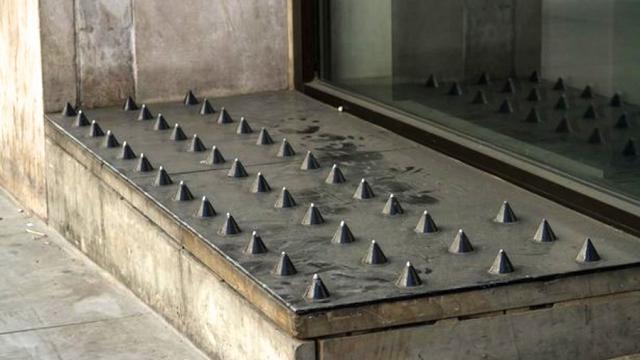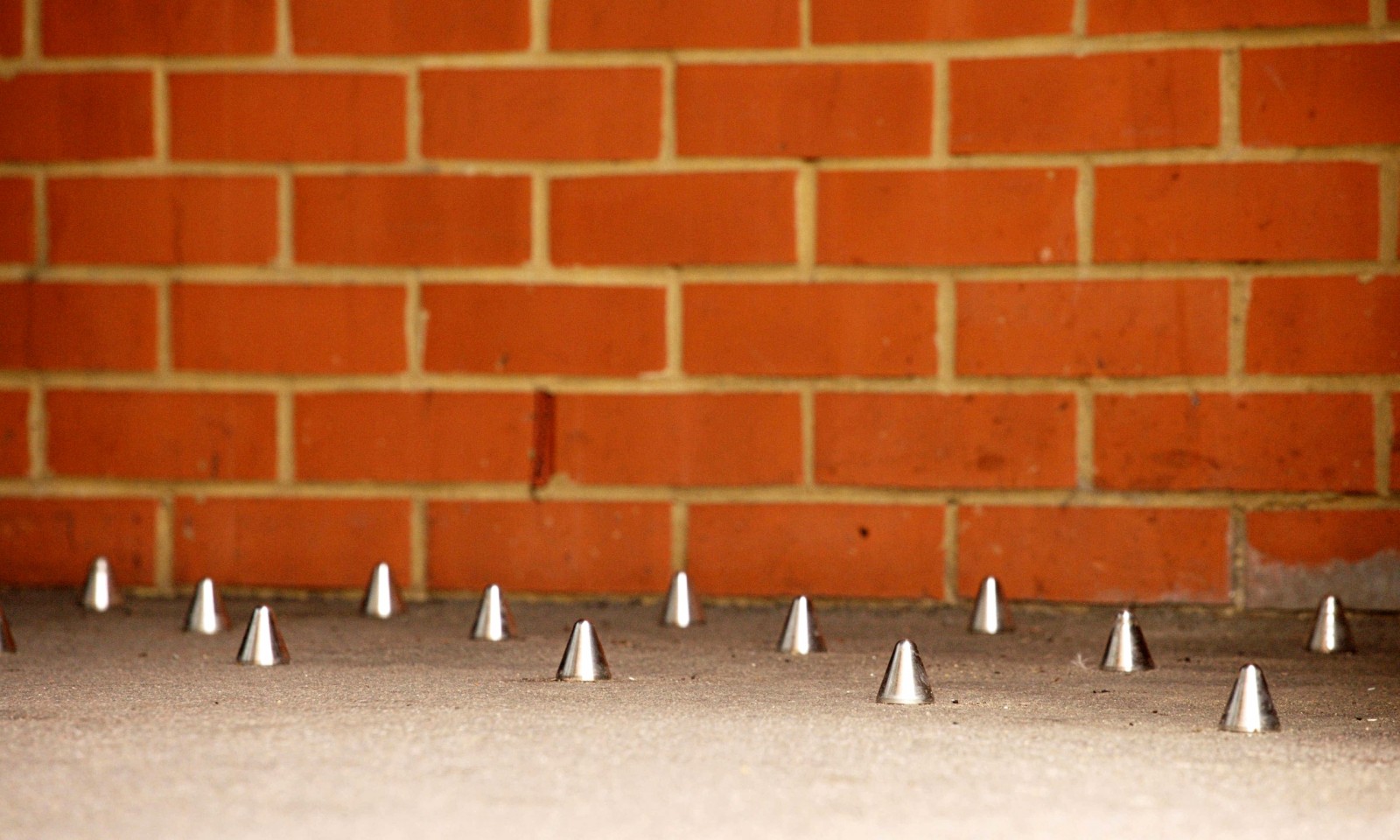
Homeless people of London came face to face with further dehumanization recently when both a supermarket and property developer erected metal spikes at building entrances in what is believed to be a means of deterring people from sleeping there.
The inch-high steel studs were assembled outside a Tesco store, one of the U.K.’s largest grocery and general merchandise retailers. Spikes were also erected in the entrance to the flats of a luxury property development.
An anonymous resident told the Telegraph that a homeless man had been sleeping in the entrance – and about a week later studs were put there, presumably as a deterrent.
Spiked Studs Provoke Controversy and Condemnation
The studs provoked widespread censure as plans for a protest outside the London store emerged. More than 600 people quickly signed up on Facebook to attend the protest. A petition on Charge.org calling to end the anti-homeless spikes attracted over 113,000 signatures in a matter of days. A group of activists were photographed pouring concrete over the spikes before running away.
Tesco management tried to backtrack on its actions, denying the spikes were put there as an anti-homeless measure. The supermarket giant claims the spikes were an attempt to prevent "antisocial behavior." . “Customers told us they were intimidated by antisocial behavior outside our Regent Street store and we put studs in place to try and stop it,” said a Tesco spokesperson.
Jacqui McCluskey of Homeless Link said: "It’s shocking to see the use of metal spikes to discourage rough sleeping and hardly helps to deal with the rising number of people who are forced to sleep on our streets.”
“Many people who sleep rough just don’t know where to turn and are among the most vulnerable in society," McCluskey added. "Sleeping on the streets is dangerous and bad for your health. Individuals need support.”
London Mayor Condemns the Spikes as "Stupid"
In response to the uproar over the spikes, London Mayor Boris Johnson called for the “ugly, stupid anti-homeless” spikes to be removed.
“Spikes outside Southwark housing development to deter rough sleeping are ugly, self-defeating and stupid. Developer should remove them ASAP,” Johnson tweeted.
Several of the top London politicians have joined Johnson in the reprise of the spikes. A spokesperson for the mayor was quick to point outthat Johnson has invested more than £34 million ($58 million) in strategies to tackle homelessness in London.
Addressing the Growing Trend
However, other sources tell a very different story. According to figures from 2013, the number of people sleeping rough on London’s streets increased by 13% since the previous year. In fact, statistics compiled by the homeless database Chain states the number of homeless people in London has almost doubled since Boris Johnson became mayor.
Up to 300 people will sleep rough on London’s streets tonight. Far from the stereotype of homeless people being drunks, heroin addicts, jobless and no hopers, the charity Streets of London says many of London’s homeless are skilled, intelligent and likeable people – and a great number of them want to work.
Real Estate and Property Developer Displeasure
But while Streets of London seeks to challenge the perception that homeless people are any different from those of us with a roof over our heads, some real estate and property development professionals are equally keen to challenge the notion that their industry is the “bad guy" in the equation.
As condemnation and controversy mounts in the U.K. about the ‘de-humane’ actions of the supermarket chain and the luxury property developer, Dan Vassiliou, CEO of Houses For Sale in America, one of the most successful American property websites in the U.K., says realtors in London are being painted in a negative light.
“It’s unfair to assume the spikes were put there as a means of deterring homeless people,” Vassiliou told Occupy.com. “Property development and regeneration is paramount to the economic growth of London. Property developers and real estate companies have a job to do, including maintaining the condition of properties.”
“In creating jobs and housing and helping drive the economy, we are the good guys who are only trying to do our job to our best. Ironically, we’re being painting as the villains,” he said.
U.K. Not Alone in Embracing Hostile Seating Designs
Using architectural devices as a means of deterring people from sleeping rough and displaying other "unwanted behavior" can be found all over the world.
In China, for example, a pay-per-system park bench was introduced on benches as a means of stopping people from sleeping or even loitering on seats in parks. Japan, meanwhile, favors tubular benches that are either too hot during the summer months or too cold during the winter, so people simply can’t get comfy on them and take a nap.
Likewise, New York’s hostile seating devices are especially brutal in their design – including spiky, anti-sit devices placed on fire hydrants, standpipes and air-conditioning units.
While many of these hostile seating tactics might be primarily focused on creating a positive movement against crime, it provokes the question: just how positive for a city can spiky anti-sit devices, inch-long metal spikes, and a park bench that turns cold in the winter when you sit on it, actually be?
3 WAYS TO SHOW YOUR SUPPORT
- Log in to post comments












